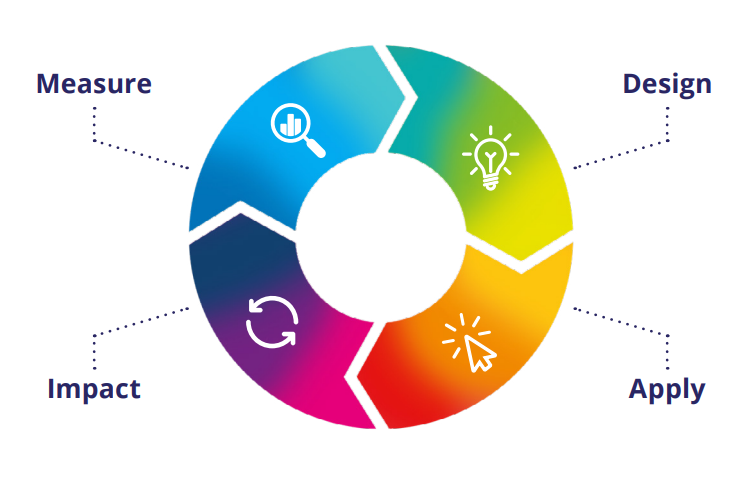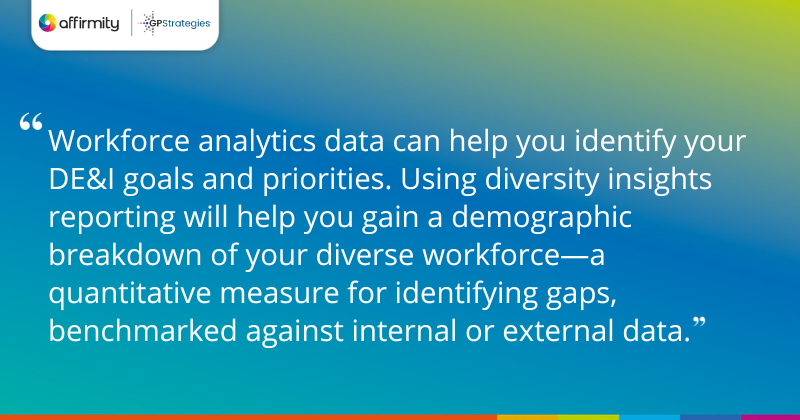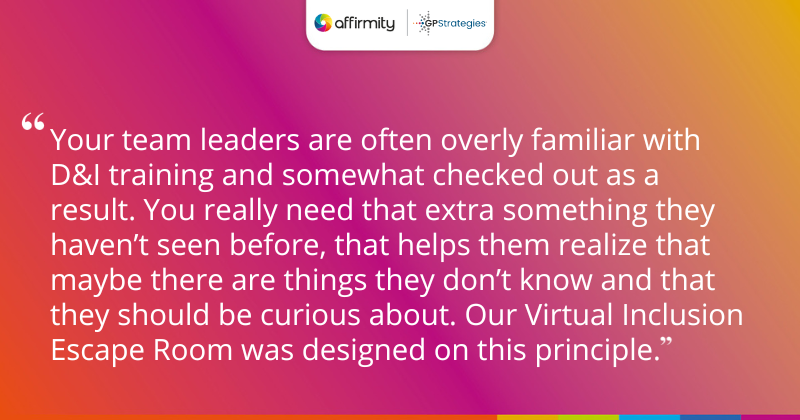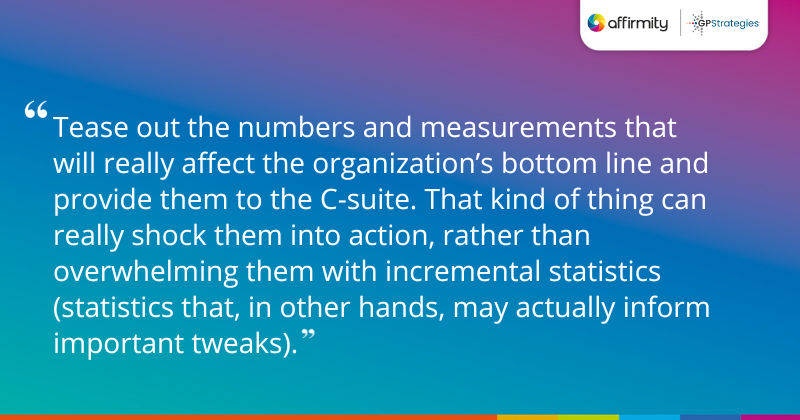The merger of PDT Global and Affirmity has meant a unique offering has arrived in the inclusion and diversity world: measurement, design, application, and impact assessment offered by one organization—under one partnership. Discover how these simple principles can be followed by any business looking to drive DE&I forward in this Q&A with PDT Global’s Angela Peacock and Affirmity’s Pam Pujo.

Phase 1: Measurement
Q: With so much to do, why start with measurement first?
Pam Pujo: If you don’t have any numbers to back it up, then you really don’t know whether you’ve made any progress. Measurement provides us with an important starting point against which you can gauge whether you’ve made any improvement in your program.
Q: What are the different measurement tools available and what should be used first?
PP: There are a number of different measurement tools to consider:
- Diversity insights reports
- Climate surveys or other questionnaires
- Audit assessments
- Pay equity analyses
- Employee engagement surveys
- Talent lifecycle analysis
- Talent velocity analysis
- Predictive analytics
With so many options, it can be unclear where to start. And in truth, there isn’t really a definitive answer for where you should start. In fact, it’s totally valid to begin with multiple measurements! It really depends on what you want to find out. For example, if you want to understand the diversity, inclusion, and engagement sides of your program, you could start with diversity insights reporting, a climate survey, and some sort of engagement survey.
Angela Peacock: We often begin with talent velocity. This is a challenging one, but essentially it takes a control group (usually the privileged group) and measures historical movement through the organization. It then looks at historically marginalized—usually a gender or racial group—and where the failure or pinch points are in their lifecycle. In this way, we can predict what the future looks like if the organization simply maintains the status quo. It’s a powerful message and tells us exactly where training or change of policy should begin.

Q: How do I integrate DE&I tasks with my organizational goals?
PP: You want to start by outlining the objective for each goal, and then the steps needed to achieve those goals, who will be accountable for implementing the goals, and a target date. And of course, you always want to talk about how you measure success.
So if your goal is to improve workplace inclusion, the objective is to foster a culture that encourages collaboration, engagement, and respect. An action you could take is providing inclusive leadership training for managers to address any hidden biases.
Workforce analytics data can help you identify your DE&I goals and priorities. Using diversity insights reporting will help you gain a demographic breakdown of your diverse workforce—a quantitative measure for identifying gaps, benchmarked against internal or external data.
Then, working with engagement or climate surveys, you could gain valuable qualitative insights—do people self-report as having a sense of belonging, or feeling included? This information can feed into your training programs, leadership development programs, and so on.
CLIMATE SURVEYS IN FOCUS | ‘How to Use a Climate Survey to Understand and Nurture Diversity and Inclusion’
Q: Pay equity is a hot topic right now. Why is it so important?
PP: Pay equity in terms of fair pay across gender lines has been a concern for some time but it’s really starting to gain a lot of traction across all diversity demographics.
AP: It’s really where the rubber hits the road. You can have all the diversity initiatives that you like but if there’s still a disparity in pay data, you know there’s a real issue there. But just measuring it isn’t enough—if there’s a disparity, you have to act quickly.
MORE ON PAY EQUITY | ‘How to Connect Your Pay Reporting Requirements to Your Pay Equity Efforts’
Q: Is there a danger of organizations benchmarking against competitors who aren’t excelling?
PP: Benchmarking doesn’t just have to be against another organization in your industry—it could be against the labor pool of talent available in your geographical area. It’s about asking whether you’re really tapping into the talent available to you. The metrics help you establish a baseline against which opportunities for improvement can be quantified, increasing transparency and accountability.
Phase 2: Design
Q: We’re quite happy with our plan already. So, what’s left to design?
Angela Peacock: This is a common perspective, but even a plan that got you through the last three years isn’t necessarily going to get you where you need to be in another three years’ time. The design stage is one that needs to be periodically reviewed, adjusted, and challenged, regardless of how well it has been working to date.
Q: Where should we start in designing or reassessing our plan?
AP: Firstly, you should get clear on what you want to achieve in terms of both diversity and inclusion as separate concerns. Inclusion tends to get mixed up with diversity, or neglected entirely.
Think of diversity as anything that if it were possible to ask—and people were willing to share—could be measured. The big illusion is that a diverse workforce is automatically good for business. However, if what’s going on outside of the people you bring in is toxic, they’re not going to perform or give their best.
Inclusion is about creating an environment where everyone with the capability to excel can do so. It’s needed to drive diversity (and equity is an essential bridge between the two).

Q: Should training be mandatory?
AP: Absolutely, yes! We’re aware that there’s research out there that suggests otherwise. However, we contend that this research looks at inclusion training, diversity training, or unconscious bias in isolation, a “we’re going to send a few people to a few training courses” approach that doesn’t work, and has never worked.
Q: So what is a better approach?
AP: Your learning pathway needs to make the most of your working year and your budget. Most importantly, it needs to cover multiple levels of your business, and it needs to be built around their unique needs.
We’re wary of sending executive teams straight into training sessions, for example. It’s far more effective to send an expert into a small Q&A session where execs can hammer out exactly what principles (like our ‘nine levers’ approach) mean to their business, and where skepticism can be aired and interrogated.
Here’s another example: your team leaders are often overly familiar with D&I training and somewhat checked out as a result. You really need that extra something they haven’t seen before, that helps them realize that maybe there are things they don’t know and that they should be curious about. Our Virtual Inclusion Escape Room was designed on this principle—its experiential elements set out to confront leaders in ways that more theoretical learning cannot.
DISCOVER KEY TALKING POINTS FOR LEADERSHIP | ‘Are You Pulling the 9 “Levers” of Inclusion?’
Q: How do we sustain DE&I learning all year long?
AP: Our learning pathway best practice always advocates for digital support. If it’s on your LMS, it’s there to support team members whenever they need it, and you’ll also benefit from knowing who’s accessing the content and speaking with their teams. Team leaders should be having mandatory conversations on DE&I topics at least once a year and there should be actions that come out of that.
Q: What else needs to go into the plan?
Process changes are one easily overlooked but essential area. When are you going to look at improvements to your recruitment or your talent process to help deliver real organizational change that will assure all employees that you’re doing the necessary work as well? If you’re holding your managers to account for advancing DE&I, when are your performance discussions happening?
Ultimately, you want a two-to-three-year overarching plan that’s transparent and a regular and ongoing point of discussion. You’ll want to avoid surprises.
Phase 3: Apply
Q: What’s the best way of applying the design?
Angela Peacock: Honestly, once all the design work is done, by far the most important thing is to just do it. However, there are key players around the business that need to be onside to maximize traction:
- Make sure HR is fully ready to support: When new learning pathways go live, the DE&I team alone may not have the bandwidth to support every manager who runs into trouble.
- Procurement is an underrated ally in general: Are they selecting diverse vendors?
- ERGs must have a plan and purpose when your designs are applied: Make sure they know what you’re doing, why you’re doing it, and what you expect them to deliver.
- Involve senior management: Obviously, if you’re planning to review processes for biases and other snagging points, the C-suite needs to know what’s coming and why.
READ OUR RESOURCE | ‘Inclusion Drives Diversity: Harnessing Inclusive Policies as an Engine for Organizational Change’

Phase 4: Impact
Q: Once the plan has been implemented, how do we measure impact?
Pam Pujo: Using your baseline measurement from the initial phase, establish either a quarterly or annual review to check your progress, considering each level at which you’ve implemented the learning pathway. Obviously, in order for your measurements to stay valid, you’ll need to remain consistent with what you were measuring at kick-off. Maintaining this will allow you to see the trend as you repeatedly reiterate your plans.
How you report impact will depend on who you’re delivering your reports to. Be prepared to slice and present in different reporting styles so that everyone really understands what has changed in the organization and what that means for them.
Angela Peacock: A good example is teasing out the numbers and measurements that will really affect the organization’s bottom line and providing them to the C-suite. That kind of thing can really shock them into action, rather than overwhelming them with incremental statistics (statistics that, in other hands, may actually inform important tweaks).
